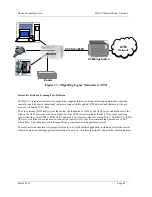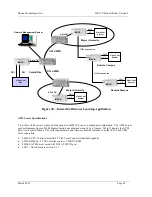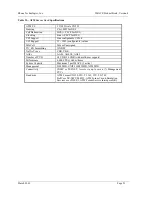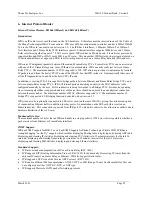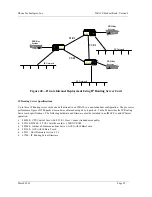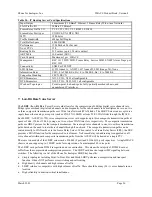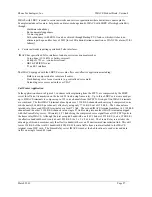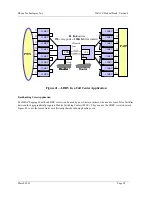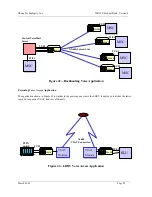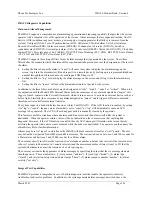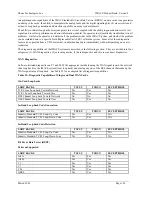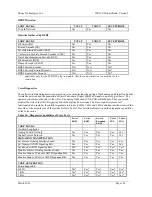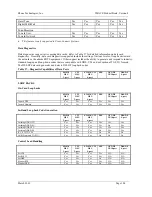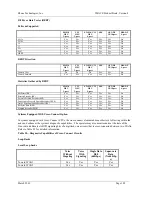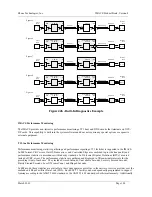
Zhone Technologies, Inc.
IMACS Product Book, Version 4
March 2001
Page 101
IMACS Diagnostic Capabilities
Status and Alarm Management
The IMACS supports a comprehensive alarm message generation and reporting capability that provides the system
operator with a complete view of the operation of the system. Alarm messages that are supported include, Out-Of-
Service (OOS) condition (any card, module, power supply or ringing generator that fails or is removed from the
system), No Signal (NOS), Loss of Synchronization (LOS), AIS alarm, CGA-Red alarm, CGA-Yellow alarm,
Excessive Error Rate (EER), Alarm card sensor (SENSOR), D-channel out of service (DCHAN), Switch to
redundant card (SWITCH), User card/port alarm (UCA), System reset (RESET), Alarm Cut-Off (ACO), Clock Sync
alarm (SYNC), Error rate above 10e-3 (EER-3), DS3 PCLP Out of Framing (PLC_OOF), DS3 PCLP Loss of Frame
(PLC_LOF) and DS3 PCLP Yellow alarm (PLC_YEL).
The IMACS supports the setting of filters for each alarm message that is generated by the system. These three
filters define the manner in which the alarm will be reported and take precedence over the designation of the level of
the alarm.
•
Setting the filter of a specific alarm to “report” will cause the system to display the alarm message on the
screen, log it into the alarm history file and report it to a remote device by dialing a pre-programmed telephone
number through the built-in modem or by sending an SNMP trap via IP.
•
Setting the filter to “log” will (a) display the alarm message on the screen and (b) log it into the alarm history
file.
•
Setting the filter to “ignore” will cause the alarm indication to be ignored by the system.
In addition to the three filters, each alarm may be designated as “info”, “major”, “minor” or “critical”. When used
in conjunction with the Model 840X External Alarm card, the occurrence of any alarm designated as “major” will
trigger a form-C contact on the External Alarm card, which in turn can serve to activate an external device such as a
bell or light. Similarly, the occurrence of any alarm designated as “minor” would trigger a different contact and,
therefore, activate a different external indicator.
The system supports a standard feature known as Alarm Cut-Off (ACO). If the ACO function is enabled, by setting
it to “log” or “report”, then any major alarm that is set to “report” or “log” will automatically cause an ACO
message to be generated. The ACO will not disappear until it is manually cleared by the operator.
This feature is useful in situations where an alarm condition occurs and then clears itself while the system is
unattended. When the operator returns, there will be no indication on the console screen that anything had
happened. However, if the ACO function is enabled, then the ACO message will remain on the screen thereby
notifying the operator that certain events occurred while the node was unattended. The operator can then query the
alarm history file for further information.
Alarms may be set to “report” in which case the IMACS will dial a remote device after a “wait” period. The user
may define the wait period for both Major and Minor alarms. The wait period can be between 1 and 500 seconds for
a Major alarm and between 1 and 32,000 seconds for a Minor alarm.
The user may specify in software the remote device’s telephone number, printout retry interval if the remote device
is busy (1 minute to 60 minutes, in 1 minute intervals) and the maximum number of times (from 1 to 99) that the
system will attempt to contact the remote device before giving up.
The user may customize the appearance of alarm messages by specifying the order that the six message elements
should appear in. Those elements are: (1) slot position (“address”), (2) card type (“model”), (3) alarm type
(“alarm”), and (4) start and stop time and date stamps (“time”), (5) alarm sequence number “number”, (6) alarm
severity (“severity”).
Integral Test Capabilities
The IMACS provides a comprehensive set of built-in diagnostic tools that enable the operator to remotely
troubleshoot and resolve problems. In addition to the system-generated alarm messages described above, the
Summary of Contents for IMACS Network Device
Page 1: ...IMACS Product Book...



